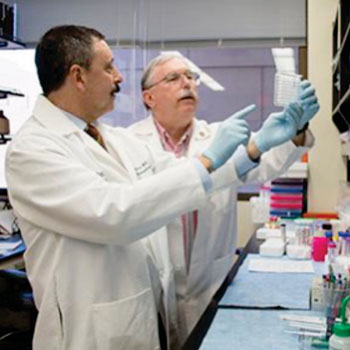Urinary Proteins Kidney Cancer Biomarkers
By LabMedica International staff writers
Posted on 30 Mar 2015
Two urinary proteins are elevated in individuals with kidney cancer (papillary renal cell carcinoma or RCC) and are candidates to serve as biomarkers for early detection of the disease.Posted on 30 Mar 2015
Successful treatment of RCC usually depends on early, pre-metastasis detection of the disease. However, more than 80% of patients die within five years when kidney cancer is not diagnosed until after it has spread.

Image: Investigators evaluate results of the AQP1 ELISA, part of a noninvasive method to screen for kidney cancer by measuring the presence of protein biomarkers in the urine (Photo courtesy of the Washington University School of Medicine).
Currently, kidney cancer is usually detected as an incidental, fortuitous finding when someone has a CT or MRI scan. These tests are not adaptable for use as a screening method, as they cannot differentiate between cancerous and non-cancerous masses in the kidney.
Investigators Washington University School of Medicine (St. Louis, MO, USA) evaluated the measurement of two urinary proteins as potential biomarkers for kidney cancers. The proteins under consideration were aquaporin-1 (AQP1) and perilipin-2 (PLIN2).
The AQP1 gene encodes an aquaporin protein that functions as a molecular water channel protein. It is a homotetramer with six bilayer spanning domains and N-glycosylation sites. The protein physically resembles channel proteins and is abundant in erythrocytes and renal tubes. The protein encoded by the PLIN2 gene belongs to the perilipin family, members of which coat intracellular lipid storage droplets. This protein is associated with the lipid globule surface membrane material, and might be involved in development and maintenance of adipose tissue. However, it is not restricted to adipocytes as previously thought, but is found in a wide range of cultured cell lines and tissues, suggesting that it may serve as a marker of lipid accumulation in diverse cell types and diseases.
For their study the investigators used a sensitive and specific ELISA technique to measure AQP1 and a Western blot procedure to measure PLIN2 in urine samples from 720 patients undergoing routine abdominal CT (screening population), 80 healthy controls, and 19 patients with pathologically confirmed RCC.
Results revealed that urine AQP1 and PLIN2 concentrations were significantly higher in the 19 patients with known RCC than in the 80 healthy controls and the 720 patient screening population. Three of the 720 patients who had abdominal CT scans also had elevated levels of both proteins. Two of those patients were diagnosed subsequently with kidney cancer. Levels of the two proteins were not elevated in the urine of patients with other types of non-cancerous kidney disease.
"By and large, patients do not know they have kidney cancer until they get symptoms, such a blood in the urine, a lump or pain in the side or the abdomen, swelling in the ankles or extreme fatigue," said first author Dr. Jeremiah J. Morrissey, professor of anesthesiology at the Washington University School of Medicine. "And by then, it is often too late for a cure. Metastatic kidney cancer is extremely difficult to treat, and if the disease is discovered after patients have developed symptoms, they almost always have metastases. So we are hoping to use these findings to quickly get a test developed that will identify patients at a time when their cancer can be more easily treated."
The study was published in the March 19, 2015, online edition of the journal JAMA Oncology.
Related Links:
Washington University School of Medicine










 (3) (1).png)



